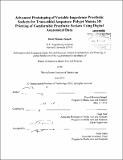| dc.contributor.advisor | Hugh Herr. | en_US |
| dc.contributor.author | Sengeh, David Moinina | en_US |
| dc.contributor.other | Massachusetts Institute of Technology. Dept. of Architecture. Program in Media Arts and Sciences. | en_US |
| dc.date.accessioned | 2013-01-23T20:23:57Z | |
| dc.date.available | 2013-01-23T20:23:57Z | |
| dc.date.copyright | 2012 | en_US |
| dc.date.issued | 2012 | en_US |
| dc.identifier.uri | http://hdl.handle.net/1721.1/76573 | |
| dc.description | Thesis (S.M.)--Massachusetts Institute of Technology, School of Architecture and Planning, Program in Media Arts and Sciences, 2012. | en_US |
| dc.description | Cataloged from PDF version of thesis. | en_US |
| dc.description | Includes bibliographical references (p. 66-68). | en_US |
| dc.description.abstract | This work, supported by the Media Lab Consortium, evaluates the design of a Variable Impedance Prosthetic (VIPr) socket for a transtibial amputee using computer-aided design and manufacturing (CAD/CAM). Compliant features are seamlessly integrated into a 3D printed socket to achieve lower interface peak pressures over bony protuberances by using anthropomorphic data acquired through surface scanning and magnetic resonance imaging techniques. An inverse linear mathematical transformation spatially maps quantitative measurements (bone tissue depth) of the human residual limb to the corresponding socket shape and impedance characteristics. The CAD/CAM VIPr socket is compared to a state-of-the-art prosthetic socket of similar internal geometry and shape, designed by a prosthetist using conventional methods. An active, bilateral transtibial male amputee of weight 70 kg walks on a force plate loaded 5-meter walkway, at self-selected speeds while synchronized ground reaction forces, motion capture data and socket residual limb interface pressures are measured for the evaluated sockets. We anticipated a decreased average interface pressure (measured using the Teksan F-SocketTM pressure sensors) in the VIPr socket, especially over stiff anatomical landmarks including the fibula head, the tibia, lateral and medial femoral condyles and medial tibial flare. Contact interface pressure recorded during stance of a complete gait cycle indicated a 15% and 17% reduction at toe-off and heel-strike respectively at the fibula head while the subject uses a VIPr socket in comparison to a conventional socket of similar internal shape. A corresponding 7% and 8% reduction in pressure is observed along the tibia. Similar trends of high-pressure reductions are observed during stair ascent trials with the VIPr socket. | en_US |
| dc.description.statementofresponsibility | by David Moinina Sengeh. | en_US |
| dc.format.extent | 68 p. | en_US |
| dc.language.iso | eng | en_US |
| dc.publisher | Massachusetts Institute of Technology | en_US |
| dc.rights | M.I.T. theses are protected by
copyright. They may be viewed from this source for any purpose, but
reproduction or distribution in any format is prohibited without written
permission. See provided URL for inquiries about permission. | en_US |
| dc.rights.uri | http://dspace.mit.edu/handle/1721.1/7582 | en_US |
| dc.subject | Architecture. Program in Media Arts and Sciences. | en_US |
| dc.title | Advanced prototyping of variable impedance prosthetic sockets for trans-tibial amputees : polyjet matrix 3D printing of comfortable prosthetic sockets using digital anatomical data | en_US |
| dc.title.alternative | Polyjet matrix three-dimensional printing of comfortable prosthetic sockets using digital anatomical data | en_US |
| dc.type | Thesis | en_US |
| dc.description.degree | S.M. | en_US |
| dc.contributor.department | Program in Media Arts and Sciences (Massachusetts Institute of Technology) | |
| dc.identifier.oclc | 823938473 | en_US |

